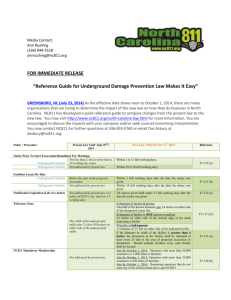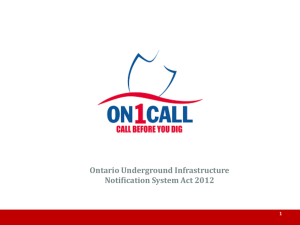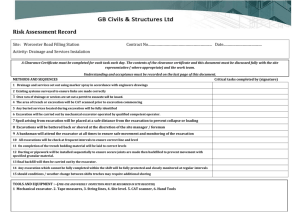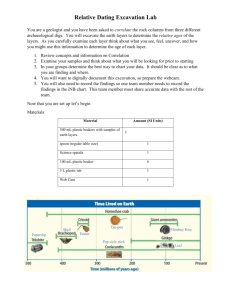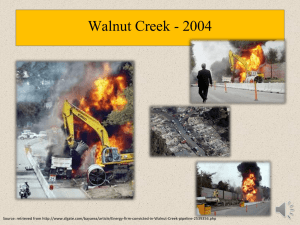Recommended Code Language for White-Lining
advertisement
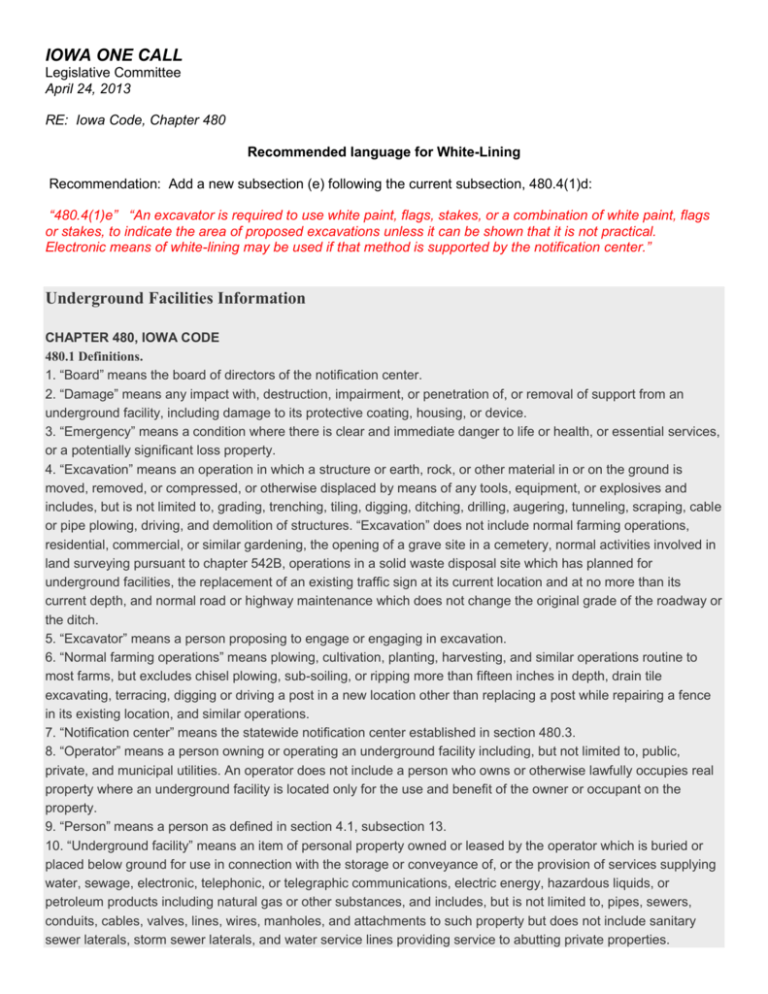
IOWA ONE CALL Legislative Committee April 24, 2013 RE: Iowa Code, Chapter 480 Recommended language for White-Lining Recommendation: Add a new subsection (e) following the current subsection, 480.4(1)d: “480.4(1)e” “An excavator is required to use white paint, flags, stakes, or a combination of white paint, flags or stakes, to indicate the area of proposed excavations unless it can be shown that it is not practical. Electronic means of white-lining may be used if that method is supported by the notification center.” Underground Facilities Information CHAPTER 480, IOWA CODE 480.1 Definitions. 1. “Board” means the board of directors of the notification center. 2. “Damage” means any impact with, destruction, impairment, or penetration of, or removal of support from an underground facility, including damage to its protective coating, housing, or device. 3. “Emergency” means a condition where there is clear and immediate danger to life or health, or essential services, or a potentially significant loss property. 4. “Excavation” means an operation in which a structure or earth, rock, or other material in or on the ground is moved, removed, or compressed, or otherwise displaced by means of any tools, equipment, or explosives and includes, but is not limited to, grading, trenching, tiling, digging, ditching, drilling, augering, tunneling, scraping, cable or pipe plowing, driving, and demolition of structures. “Excavation” does not include normal farming operations, residential, commercial, or similar gardening, the opening of a grave site in a cemetery, normal activities involved in land surveying pursuant to chapter 542B, operations in a solid waste disposal site which has planned for underground facilities, the replacement of an existing traffic sign at its current location and at no more than its current depth, and normal road or highway maintenance which does not change the original grade of the roadway or the ditch. 5. “Excavator” means a person proposing to engage or engaging in excavation. 6. “Normal farming operations” means plowing, cultivation, planting, harvesting, and similar operations routine to most farms, but excludes chisel plowing, sub-soiling, or ripping more than fifteen inches in depth, drain tile excavating, terracing, digging or driving a post in a new location other than replacing a post while repairing a fence in its existing location, and similar operations. 7. “Notification center” means the statewide notification center established in section 480.3. 8. “Operator” means a person owning or operating an underground facility including, but not limited to, public, private, and municipal utilities. An operator does not include a person who owns or otherwise lawfully occupies real property where an underground facility is located only for the use and benefit of the owner or occupant on the property. 9. “Person” means a person as defined in section 4.1, subsection 13. 10. “Underground facility” means an item of personal property owned or leased by the operator which is buried or placed below ground for use in connection with the storage or conveyance of, or the provision of services supplying water, sewage, electronic, telephonic, or telegraphic communications, electric energy, hazardous liquids, or petroleum products including natural gas or other substances, and includes, but is not limited to, pipes, sewers, conduits, cables, valves, lines, wires, manholes, and attachments to such property but does not include sanitary sewer laterals, storm sewer laterals, and water service lines providing service to abutting private properties. 480.1A Applicability — Prohibition. This chapter applies to any excavation unless otherwise provided by law. A person shall not engage in any excavation unless the requirements of this chapter have been satisfied. Section 480.3, Code 1991, is amended by striking the section and inserting in lieu thereof the following: 480.3 Notification Center Established — Participation. 1. a. A statewide notification center is established and shall be organized as a nonprofit corporation pursuant to chapter 504A. (1) The center shall be governed by a board of directors which shall represent and be elected by operators, excavators, and other persons who participate in the center. The board, with input from all interested parties, shall determine the operating procedures and technology needed for a single statewide notification center and establish a notification process. (2) In addition, the board shall either establish a competitive bidding procedure to select a vendor to provide the notification service or retain sufficient and necessary staff to provide the notification service. (a) If a vendor is selected, the vendor contract shall be for a three-year period, which may be extended upon the approval of the board for a period not exceeding an additional three years. The terms of the vendor contract may be modified from time to time by the board and the vendor. The contract shall be reviewed, with an opportunity to receive new bids, at the end of the term of the contract. (b) If the board retains staff to provide the notification service, the board, at the board’s discretion, may review the notification service at any time and make a determination to use the competitive bidding procedure to select a vendor. b. Upon the selection of a vendor pursuant to paragraph “a”, the board shall notify the chairperson of the utilities board in writing of the selection. The board shall submit an annual report to the chairperson of the utilities board including an annual audit and review of the services provided by the notification center and the vendor. c. The board is subject to chapters 21 and 22. 2. The board shall implement the latest and most cost-effective technological improvements for the center in order to provide operators and excavators with the most accurate data available and in a timely manner to allow operators and excavators to perform their responsibilities with the minimum amount of interruptions. 3. Every operator shall participate in and share in the costs of the notification center. The financial condition and the transactions of the notification center shall be audited at least once each year by a certified public accountant. The notification center shall not provide any form of aid or make a contribution to a political party or to the campaign of a candidate for political or public office. In addition to any applicable civil penalty, as provided in section 480.6, a violation of this section constitutes a simple misdemeanor. Section History: Recent form 87 Acts, ch 135, § 3; 92 Acts, ch 1103, § 3; 95 Acts, ch 112, § 1; 98 Acts, ch 1049, §1; 2002 Acts, ch 1054, §1 480.4 Required Notice — Location and Marking of Underground Facilities — Exception. 1. a. Except as otherwise provided in this section, prior to any excavation, an excavator shall contact the notification center and provide notice of the planned excavation. This notice must be given at least forty-eight (48) hours prior to the commencement of the excavation, excluding Saturdays, Sundays, and legal holidays. The notification center shall establish a toll-free telephone number to allow excavators to provide the notice required pursuant to this subsection. b. A notice provided pursuant to this subsection for a location within a city shall include the following information: 1. A street address or block and lot numbers, or both, of the proposed area of excavation. 2. The name and address of the excavator. 3. The excavator’s telephone number. 4. The type and extent of the proposed excavation. 5. Whether the discharge of explosives is anticipated. 6. The date and time when excavation is scheduled to begin. 7. Approximate location of the excavation on the property. 8. If known, the name of the housing development and property owner. c. A notice provided pursuant to this subsection for a location outside a city shall include the following information: 1. The name of the county, township, range, and section. 2. The name and address of the excavator. 3. The excavator’s telephone number. 4. The type and extent of the proposed excavation. 5. Whether the discharge of explosives is anticipated. 6. The date and time when excavation is scheduled to begin. 7. Approximate location of the excavation on the property. 8. If known, the quarter section, E911 address and global positioning system coordinate, name of property owner, name of housing development with street address or block and lot numbers, or both. d. For purposes of the requirements of this section, an excavation commences the first time excavation occurs in an area that was not previously identified by the excavator in an excavation notice. e. An excavator is required to use white paint, flags, stakes, or a combination of white paint, flags or stakes, to indicate the proposed area of excavations unless it can be shown that it is not practical. Electronic means of white-lining may be used if that method is supported by the notification center 2. The notification center, upon receiving notice from an excavator, shall immediately transmit the information contained in the notice to each operator in the area of the proposed excavation and provide the names of all operators in that area to the excavator. The notification center shall assign an inquiry identification number to each notice and shall maintain a record of each notice for at least six (6) years from the date the notice is received. The notification center shall not assess an operator who requests in writing not to receive a notification of its own excavations for any portion of the costs associated with such excavations. 3. a. (1) An operator who receives notice from the notification center shall mark the horizontal location of the operator’s underground facility and the excavator shall use due care in excavating in the marked area to avoid damaging the underground facility. The operator shall complete such locating and marking within forty-eight (48) hours after receiving the notice, excluding Saturdays, Sundays, and legal holidays, unless otherwise agreed by the operator and the excavator. The locating and marking of the underground facilities shall be completed at no cost to the excavator. If, in the opinion of the operator, the planned excavation requires that the precise location of the underground facilities be determined, the excavator, unless otherwise agreed upon between the excavator and the operator, shall hand dig test holes to determine the location of the facilities unless the operator specifies an alternate method. (2) The marking required under this subsection shall be done in a manner that will last for a minimum of five working days on any nonpermanent surface, or a minimum of ten working days on any permanent surface. If the excavation will continue for any period longer than such periods, the operator shall remark the location of the underground facility upon the request of the excavator. The request shall be made through the notification center. b. An operator who receives notice from the notification center and who determines that the operator does not have any underground facility located within the proposed area of excavation shall notify the excavator concerning this determination prior to the indicated date of commencement of excavation. c. For purposes of this chapter, the “horizontal location of any underground facility” is defined as including an area eighteen (18) inches on either side of the underground facility. 4. An excavator is responsible for preserving the markings required in subsection 3 at all times during the excavation. If the markings will be destroyed or otherwise altered during the excavation, the excavator must establish suitable reference points which will enable the excavator to locate the underground facility at all times during the excavation. 5. The operator shall mark the location of any underground facility to conform with the uniform color code established by the American public works association’s utility location and coordination council. 6. The only exception to this section shall be when an emergency exists. Under such conditions, excavation operations can begin immediately, provided reasonable precautions are taken to protect the underground facilities. The excavator shall notify the notification center of the excavation as soon as practical. 480.5 Damage to Underground Facility — Report to Operator. An excavator shall, as soon as practical, notify the operator when any damage occurs to an underground facility as a result of an excavation. The notice shall include the type of facility damaged and the extent of the damage. If damage occurs, an excavator shall refrain from backfilling in the immediate area of the underground facilities until the damage has been investigated by the operator, unless the operator authorizes otherwise. If the damage results in an emergency, the excavator shall take all reasonable actions to alleviate the emergency including, but not limited to, the evacuation of the affected area. The excavator shall leave all equipment situated where the equipment was at the time the emergency was created and immediately contact the operator and appropriate authorities and necessary emergency response agencies. 480.6 Civil penalties. 1. A person who violates a provision of this chapter is subject to a civil penalty as follows: a. For a violation related to natural gas and hazardous liquid pipelines, an amount not to exceed ten thousand dollars for each violation for each day the violation continues, up to a maximum of five hundred thousand dollars. b. For a violation related to any other underground facility, an amount not to exceed one thousand dollars for each violation for each day the violation continues, up to a maximum of twenty thousand dollars. 2. The attorney general, upon the receipt of a complaint, may institute any legal proceedings necessary to enforce the penalty provisions of this chapter. 3. All amounts collected pursuant to this section shall be remitted to the Treasurer of State, who shall deposit the amount in the general fund of the state. 480.7 Injunction. Any affected person may make application to the district court for injunctive relief from any violation of this chapter. 480.8 Local Ordinances and Regulations Unaffected. This chapter does not affect or impair any local ordinances or other provisions of law requiring permits to be obtained before excavation. However, a permit issued by any governing body does not relieve the excavator from complying with the requirements of this chapter, unless the governing body is the excavator and the governing body and the operator have agreed in writing to waive notification under this chapter. However, such an agreement shall not be considered in the issuance of any required permit. Sec. 9. Section 479.47, unnumbered paragraph 2, Code 1991, is amended by striking the paragraph. Sec. 10. Section 479A.26, unnumbered paragraphs 2 and 3, Code 1991, are amended by striking the paragraphs. Sec. 11. Section 478.36 and 480.2, Code 1991, are repealed. Sec. 12. This Act takes effect on January 1, 1993. 480.9 Liability for Owner of Farmland. An owner of farmland used in a farm operation, as defined in section 352.2, who complies with the requirements of this chapter shall not be held responsible for any damages to an underground facility, including fiber optic cable, if the damage occurred on the farmland in the normal course of the farm operation, unless the owner intentionally damaged the underground facility or acted with wanton disregard or recklessness in causing the damage to the underground facility. For purposes of this section, an “owner” includes a family member, employee, or tenant of the owner.
